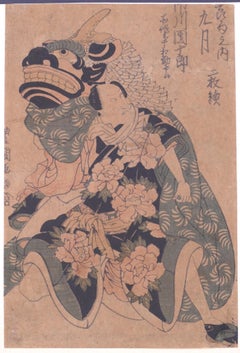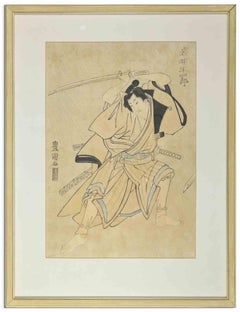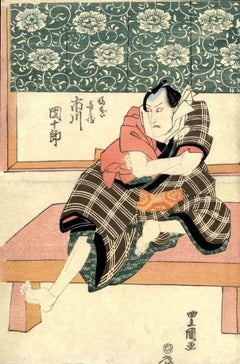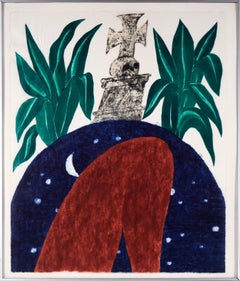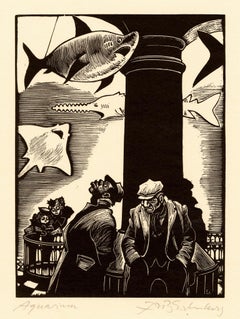Utagawa Toyokuni I Art
to
2
1
Overall Width
to
Overall Height
to
3
2
3
3
2
2
2
1
1
1
1
3
1
3
7,790
4,999
2,504
1,374
1
2
3
Artist: Utagawa Toyokuni I
Man with the Dragon - Woodblock Print by Utagawa Toyokuni I - 1800 ca
By Utagawa Toyokuni I
Located in Roma, IT
Man with the Dragon is a superb color woodbloock print on rice-paper, realized by the great master of ukiyo-e print, Utagawa Toyokuni I (1769-1825)
Depicti...
Category
Early 1800s Utagawa Toyokuni I Art
Materials
Paper, Woodcut
Actor Iwai Hanshiro as a Samurai by Utagawa Toyokuni I - Early 19th Century
By Utagawa Toyokuni I
Located in Roma, IT
Actor Iwai Hanshiro as a Samurai is an artwork realized by Utagawa Toyokuni (1769-1825), in the early 19th Century
Color woodcut, signed or inscribed in the top right and bottom lef...
Category
Early 19th Century Modern Utagawa Toyokuni I Art
Materials
Woodcut
Ichikawa Danjuro in the Role of Chobei - Woodcut by Utagawa Toyokuni - 1810s
By Utagawa Toyokuni I
Located in Roma, IT
Ichikawa Danjuro in the role of Chobei is an original modern artwork realized by Utagawa Toyokuni (Edo, 1769 – Edo, 1825).
Original Woodcut Print.
Oban from a Triptych, around 1810.
The actor Ichikawa Danjuro sitting on a bench and fretting, behind him a green curtain with peony motif.
Signed: Toyokuni ga. Publisher: Yamamotoya Heikichi.
Excellent impression, cut, centrefold, a little bit rubbed and soiled.
Utagawa Toyokuni (Edo, 1769 – Edo, 1825), also often referred to as Toyokuni I...
Category
1810s Modern Utagawa Toyokuni I Art
Materials
Woodcut
Related Items
"Grave of Santa Anna's Leg" Original Woodblock Print, Signed Artist's Proof
By Carol Summers
Located in Soquel, CA
"Grave of Santa Anna's Leg" Original Woodblock Print, Signed Artist's Proof
Boldly colored woodblock print by Carol Summers (American, 1925-2016). This piece is a segment of a grave, with a headstone that has a skull and cross. There are two bright green plants flanking the headstone. Below the headstone and plants, there is a large arched blue shape, with a crescent moon and stars. A red leg, bent at the knee, cuts across the blue arch.
Signed "Carol Summers" along the right edge of the blue shape.
Numbered and titled "A/P Grave of Sant Anna's Leg" along the left edge of the blue shape.
Presented in a silver colored aluminum frame.
Frame size: 32.245"H x 27.25"W
Paper size: 29.75"H x 24.5"W
Carol Summers (1925-2016) has worked as an artist throughout the second half of the 20th century and into the first years of the next, outliving most of his mid-century modernist peers. Initially trained as a painter, Summers was drawn to color woodcuts around 1950 and it became his specialty thereafter. Over the years he has developed a process and style that is both innovative and readily recognizable. His art is known for it’s large scale, saturated fields of bold color, semi-abstract treatment of landscapes from around the world and a luminescent quality achieved through a printmaking process he invented.
In a career that has extended over half a century, Summers has hand-pulled approximately 245 woodcuts in editions that have typically run from 25 to 100 in number. His talent was both inherited and learned. Born in 1925 in Kingston, a small town in upstate New York, Summers was raised in nearby Woodstock with his older sister, Mary. His parents were both artists who had met in art school in St. Louis. During the Great Depression, when Carol was growing up, his father supported the family as a medical illustrator until he could return to painting. His mother was a watercolorist and also quite knowledgeable about the different kinds of papers used for various kinds of painting. Many years later, Summers would paint or print on thinly textured paper originally collected by his mother.
From 1948 to 1951, Carol Summers trained in the classical fine and studio arts at Bard College and at the Art Students League of New York. He studied painting with Steven Hirsh and printmaking with Louis Schanker. He admired the shapes and colors favored by early modernists Paul Klee (Sw: 1879-1940) and Matt Phillips (Am: b.1927- ). After graduating, Summers quit working as a part-time carpenter and cabinetmaker (which had supported his schooling and living expenses) to focus fulltime on art. That same year, an early abstract, Bridge No. 1 was selected for a Purchase Prize in a competition sponsored by the Brooklyn Museum.
In 1952, his work (Cathedral, Construction and Icarus) was shown the first time at the Museum of Modern Art in New York City in an exhibition of American woodcuts...
Category
1980s Contemporary Utagawa Toyokuni I Art
Materials
Ink, Handmade Paper, Woodcut
H 32.25 in W 27.25 in D 1 in
'The Aquarium' — WPA Era Graphic Modernism
By Fritz Eichenberg
Located in Myrtle Beach, SC
Fritz Eichenberg, 'The Aquarium', wood engraving, 1933, edition 200. Signed and titled in pencil. Initialed in the block, lower right. A superb, richly-inked impression, on pale yel...
Category
1930s American Modern Utagawa Toyokuni I Art
Materials
Woodcut
3 Jewish Men Judaica Woodblock Woodcut Engraving Print Chicago 1930s WPA Artist
By Todros Geller
Located in Surfside, FL
Todros Geller (1889 – 1949) was a Jewish American artist and teacher best known as a master printmaker and a leading artist among Chicago’s art community.Geller was born in Vinnytsia, the Russian Empire (now Ukraine) in 1889.[2] He studied art in Odessa and continued his studies after moving to Montreal in 1906 where he immigrated to Canada. He married and moved to Chicago in 1918, where he studied at the School of the Art Institute of Chicago until 1923.
Geller produced paintings, woodcuts, woodcarvings, and etchings. His work focused on Jewish tradition, often including moralistic themes and social commentary, shtetl, ghetto life, and the intersection of Jewish tradition with modern-day Chicago. He regarded art as a tool for social reform and he spent a large part of his career teaching art. His work was commissioned for stained glass windows, bookplates, community centers and Yiddish and English books. He was regarded as a leader in the field of synagogue and religious art. He designed stained glass window for synagogues in Omaha, Fort Worth, Dayton, Stamford, and Chicago Heights. Over the course of his career he illustrated more than 40 books.
In addition to conducting classes in his studio, Geller was head of art at the Jewish People’s Institute (JPI), supervisor of art for the Board of Jewish Education and director of art for the College of Jewish Studies (which became the Spertus Institute for Jewish Learning and Leadership) and taught at Hull House. Many prominent Chicago artists studied drawing and painting under Geller. Geller was a source of inspiration to Aaron Bohrod and Mitchell Siporin...
Category
Early 20th Century Modern Utagawa Toyokuni I Art
Materials
Paper, Woodcut
Japanese Figurative Edo Woodblock Set of Two
By Toyohara Kunichika
Located in Soquel, CA
Alluring two-piece edo woodblock print of Japanese actors by Toyohara Kunichika (Japanese, 1835-1900). Titled, dated and signed on verso. Presented...
Category
1880s Edo Utagawa Toyokuni I Art
Materials
Ink, Woodcut, Paper
THE RUG WEAVER
By Gustave Baumann
Located in Santa Monica, CA
GUSTAVE BAUMANN (1881 – 1971)
THE RUG WEAVER, 1910 (Chamberlain 26)
Color woodcut signed in pencil. Unnumbed from an edition 100 as published in the Hills o’ Brown...
Category
1910s American Modern Utagawa Toyokuni I Art
Materials
Woodcut
'A Visit to the King of the Waters' — Graphic Modernism
By Fritz Eichenberg
Located in Myrtle Beach, SC
Fritz Eichenberg, 'A Visit to the King of the Waters' from the suite 'The Adventurous Simplicissimus', wood engraving, 1977, artist's proof apart from the edition of 50. Signed in pencil. Signed in the block, lower right. A fine, richly-inked impression, on cream wove paper, with full margins (1 1/2 to 2 inches), in excellent condition. Image size 14 x 12 inches (356 x 305 mm); sheet size 17 1/2 x 15 inches (445 x 381 mm). Archivally sleeved, unmatted.
ABOUT THIS WORK
'Simplicius Simplicissimus' (German: Der abenteuerliche Simplicissimus Teutsch) is a picaresque novel of the lower Baroque style, written in five books by Hans Jakob Christoffel von Grimmelshausen published in 1668, with the sequel Continuatio appearing in 1669.
The novel is told from the perspective of its protagonist Simplicius, a rogue or picaro typical of the picaresque novel, as he traverses the tumultuous world of the Holy Roman Empire during the Thirty Years' War. Raised by a peasant family, he is separated from his home by foraging dragoons. He is adopted by a hermit living in the forest, who teaches him to read and introduces him to religion. The hermit also gives Simplicius his name because he is so simple that he does not know his own name. After the death of the hermit, Simplicius must fend for himself. He is conscripted at a young age into service and, from there, embarks on years of foraging, military triumph, wealth, prostitution, disease, bourgeois domestic life, and travels to Russia, France, and an alternate world inhabited by mermen. The novel ends with Simplicius turning to a life of hermitage, denouncing the world as corrupt.
ABOUT THE ARTIST
Fritz Eichenberg (1901–1990) was a German-American illustrator and arts educator who worked primarily in wood engraving. His best-known works were concerned with religion, social justice, and nonviolence.
Eichenberg was born to a Jewish family in Cologne, Germany, where the destruction of World War I helped to shape his anti-war sentiments. He worked as a printer's apprentice and studied at the Municipal School of Applied Arts in Cologne and the Academy of Graphic Arts in Leipzig, where he studied under Hugo Steiner-Prag. In 1923 he moved to Berlin to begin his career as an artist, producing illustrations for books and newspapers. In his newspaper and magazine work, Eichenberg was politically outspoken and sometimes wrote and illustrated his reporting.
In 1933, the rise of Adolf Hitler drove Eichenberg, who was a public critic of the Nazis, to emigrate with his wife and children to the United States. He settled in New York City, where he lived most of his life. He worked in the WPA Federal Arts Project and was a member of the Society of American Graphic Artists.
In his prolific career as a book illustrator, Eichenberg portrayed many forms of literature but specialized in works with elements of extreme spiritual and emotional conflict, fantasy, or social satire. Over his long career, Eichenberg was commissioned to illustrate more than 100 classics by publishers in the United States and abroad, including works by renowned authors Dostoyevsky, Tolstoy, Charlotte and Emily Brontë, Poe, Swift, and Grimmelshausen. He also wrote and illustrated books of folklore and children's stories.
Eichenberg was a long-time contributor to the progressive magazine The Nation, his illustrations appearing between 1930 and 1980. Eichenberg’s work has been featured by such esteemed publishers as The Heritage Club, Random House, Book of the Month Club, The Limited Editions Club, Kingsport Press, Aquarius Press, and Doubleday.
Raised in a non-religious family, Eichenberg had been attracted to Taoism as a child. Following his wife's unexpected death in 1937, he turned briefly to Zen Buddhist meditation, then joined the Religious Society of Friends in 1940. Though he remained a Quaker until his death, Eichenberg was also associated with Catholic charity work through his friendship with Dorothy Day...
Category
1970s American Modern Utagawa Toyokuni I Art
Materials
Woodcut
'The Steps' — WPA Era Graphic Modernism
By Fritz Eichenberg
Located in Myrtle Beach, SC
Fritz Eichenberg, 'The Steps', wood engraving, 1933, edition 200. Signed, titled, and annotated 'Ed. 200' in pencil. Initialed in the block, lower right. A superb, richly-inked impr...
Category
1930s American Modern Utagawa Toyokuni I Art
Materials
Woodcut
Joseph Zirker, Playhouse
By Joseph Zirker
Located in New York, NY
In the 1950s woodcuts started to get bigger and bigger as they competed with paintings for a space on the wall. This California print by Joseph Zirke...
Category
1950s American Modern Utagawa Toyokuni I Art
Materials
Woodcut
'Lot Cleaning, Los Angeles' — 1930s Modernism
By Paul Landacre
Located in Myrtle Beach, SC
'Lot Cleaning, Los Angeles', wood engraving, edition 60, Zeitlin & Ver Brugge 69. Signed, titled and numbered '51/60' in pencil. A brilliant, black impression, on Kitakata Japan pape...
Category
1930s American Modern Utagawa Toyokuni I Art
Materials
Woodcut
"The Kaminarimon at the Kanseon Temple in Asakusa" - Original Japanese Print
Located in Soquel, CA
"The Kaminarimon at the Kanseon Temple in Asakusa" - Original Japanese Print
Japanese Print "The Kaminarimon at the Kanseon Temple in Asakusa", from the series "Famous Places in Ed...
Category
1850s Showa Utagawa Toyokuni I Art
Materials
Rice Paper, Woodcut
On the Beach (Coney Island, New York) — 1930s Graphic Modernism, WPA
By Lou Barlow
Located in Myrtle Beach, SC
Lou Barlow (Louis Breslow), 'On the Beach' (Coney Island) wood engraving, c. 1937, edition c. 25. Signed and titled in pencil. Stamped 'FEDERAL ART PROJECT NYC WPA' in the bottom left margin. A fine, richly-inked impression, with all the fine lines printing clearly, on cream wove paper, with full margins (1 1/2 to 3 inches), in excellent condition. Matted to museum standards, unframed. Scarce.
Image size 11 x 8 1/8 inches; sheet size 16 x 11 3/8 inches.
Created during the Great Depression for the Works Progress Administration (WPA), Federal Art Project, New York City.
Impressions of this work are in the permanent collections of the Amon Carter Museum of Art, Illinois State Museum, and the New York Public Library.
ABOUT THE IMAGE
Due to Coney Island's proximity to Manhattan, Brooklyn, and other New York boroughs, it began attracting vacationers in the 1830s and 1840s. Most of the vacationers were wealthy and went by carriage roads and steamship services that reduced travel time from a formerly half-day journey to two hours. By the late 1870s, the development of Coney Island's amusement park attractions and hotels drew people from all social classes. When the Brooklyn Rapid Transit Company electrified the steam railroads and connected Brooklyn to Manhattan via the Brooklyn Bridge at the beginning of the 20th century, Coney Island turned rapidly from a resort to an accessible location for day-trippers seeking to escape the summer heat in New York City's tenements. In 1915, the Sea Beach Line was upgraded to a subway line, and the opening of the Stillwell Avenue station in 1919 ushered in Coney Island's busiest era. On the peak summer days, over a million people would travel to Coney Island. In 1937, New York City purchased a 400-foot-wide strip of land along the shoreline to allow the boardwalk to be moved 300 feet inland. At this point, Coney Island was so crowded on summer weekends that parks commissioner Robert Moses...
Category
1930s American Modern Utagawa Toyokuni I Art
Materials
Woodcut
'The Yankee' — America's Cup, 1934
By Jacques La Grange
Located in Myrtle Beach, SC
Jacques La Grange, 'The Yankee', color woodcut, edition 500, 1934. Signed and numbered '25/500' in pencil. A fine impression, with fresh colors, on cream wove paper, with margins (1 1/8 to 1 1/4 inches), in excellent condition. A work from La Grange’s celebrated series of woodcuts 'Drama and Color in the America's Cup Races'. Image size 10 x 10 11/16 inches (254 x 271 mm); sheet size 12 1/4 x 13 1/4 inches (311 x 337 mm). Archivally matted to museum standards, unframed.
When the artist created this print in 1934, the 'Yankee' was one of the most promising yachts eligible for the America's Cup but ultimately 'Rainbow' was chosen to defend against England's 'Endeavor' in that year's race. The 'Endeavor' was built for Thomas Sopwith who used his aviation design expertise to ensure the yacht was the most advanced of its day with a steel hull and mast. She was launched in 1934 and won many races in her first season but the Cup challenge was blighted by a strike of Sopwith's professional crew prior to departing for America. Forced to rely mainly on keen amateurs, who lacked the necessary experience, the campaign failed. 'Rainbow' won the series 4–2. This was one of the most contentious of the America's Cup battles and prompted the headline "Britannia rules the waves and America waives the rules."
ABOUT THE ARTIST
Jacques La Grange was born in Clanwilliam (near Cape Town) in South Africa in 1895. He studied at London University and later immigrated to the United States. La Grange established himself as a painter, illustrator, and printmaker specializing in nautical subjects. He and his wife, Helen La Grange, published 'Drama and Color in the America's Cup Races' in 1934 and 'Clipper Ships of America and Great Britain 1833-1869', in 1936. Both were deluxe hardcover limited edition volumes with signed original color woodblock prints. La Grange had solo exhibitions at the Buchanan Gallery in 1929; the Babcock Gallery and the 56th Street Gallery, New York, in 1930; and at the Nicholas Roerich...
Category
1930s American Modern Utagawa Toyokuni I Art
Materials
Woodcut
Utagawa Toyokuni I art for sale on 1stDibs.
Find a wide variety of authentic Utagawa Toyokuni I art available for sale on 1stDibs. You can also browse by medium to find art by Utagawa Toyokuni I in woodcut print, paper and more. Much of the original work by this artist or collective was created during the 19th century and is mostly associated with the modern style. Not every interior allows for large Utagawa Toyokuni I art, so small editions measuring 9 inches across are available. Utagawa Toyokuni I art prices can differ depending upon medium, time period and other attributes. On 1stDibs, the price for these items starts at $568 and tops out at $668, while the average work can sell for $602.
